Last updated on May 1st, 2024
Featured image: The intricate and stunning facade of Basilica di Santa Croce, carved from Lecce stone / Photo by acediscovery via Wikimedia Commons
Lecce in the low season
by Carolyn Ray
Called the ‘Florence of the South’, Lecce, Italy is a Baroque jewel, with winding cobblestone streets, adorable shops and restaurants, over 100 churches, palaces, archeological museums and Roman ruins. Built on the site of the ancient Roman town of Lupiae 2,000 years ago, Lecce is the kind of place you’ll want to get lost in, as I did in my two-week stay in this charming town.
The pride of Lecce — its beautiful, straw-coloured stone — is found everywhere — in its Baroque cathedrals, buildings, monuments and churches. There are three things that make this stone special. The first is its colour — it practically glows, giving an otherworldly feeling. The second is its softness, which allows it to be sculpted into intricate and ornate fruits, dancing cherubs, altars and animals. The third is that it hardens, surviving intact for centuries. It’s no wonder that Lecce, its Baroque stone, and monuments like the Basilica di Santa Croce have become world famous.
In February, Lecce is quiet and peaceful, with most of the shops and restaurants open. The weather is balmy, and I am able to work outside in the afternoons. When it comes to predicting the weather, I learn that it’s the wind direction that really matters, not the temperature. When the wind comes from the north there will be rain, and a southern wind that curls around the tip of Italy from Africa means warm weather. (Check the Accuweather website to learn more.) Locals tell me the high season is from April to June, and September to October, so I’m here at the perfect time.
What to see and do in Lecce
With a population of about 95,000 people, Lecce is much smaller than its northern neighbour Bari. Lecce’s main attraction is the old town, which is surrounded by a medieval wall and gates and is very well preserved. From Bari, the train is about 90 minutes and the walk to the old town takes about 15 minutes. Driving in the old town requires a permit, but you can find paid parking outside the city gates. In the low season, there were no lineups and no reservations required. Check train schedules here.
1. Stand in awe of the Baroque architecture
Even for those who have experienced Baroque architecture, the highly ornate style that was popular in the 17th and 18th centuries in Europe, the Basilica di Santa Croce will make you gasp out loud. This Basilica is even more extravagant than some of the cathedrals I saw in Prague, with its gold and gilt, not to mention the main nave, which is covered by a ceiling of walnut wood.
While work started in 1549 under the guidance of architect Francesco Antonio Zimbalo, it was not completed for another century by Cesare Penna and Antonio’s son Giuseppe Zimbalo, a sculptor who even put his own self-portrait into the figures around the rose window. The outside of the building is covered with figures and adorned with 13 winged angels. It has to be seen to be believed.
There are many churches and cathedrals to see in Lecce, but don’t miss the Cathedral of Lecce (the Cathedral of Our Lady of the Assumption) with its two facades and bell tower in the main square. The Church of Santa Chiara was founded in 1429 by the Bishop of Lecce and finished in 1438. In addition to its Baroque elements, what makes this church unique is that the ceiling is octagonal. There are several packages available to visit various churches, cathedrals and museums ranging from 12 euros to 21 euros, that can be used over a series of days. Learn more here or book a walking tour here!
Not all the churches require paid admission. One morning, I step into Chiesa di Sant’Irene, a church that is closed every time I’ve came to see it. Saint Irene is the former patron saint of Lecce. It’s early, and I’m the only person there. The Lecce limestone walls are bathed in morning sunshine, gleaming. I’m not religious but I still say a prayer of thanks for the opportunity to witness the stillness.
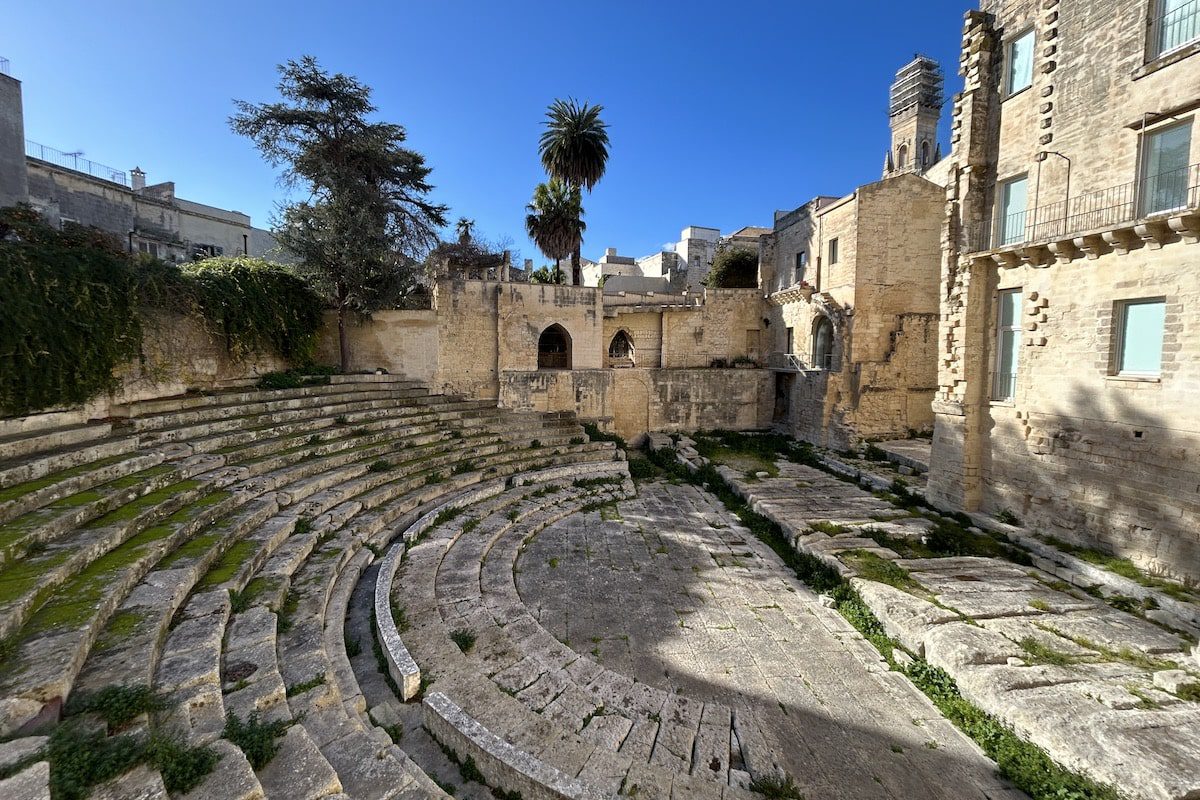
Museo del Teatro Romano / Photo by Carolyn Ray
2. Step into Lecce’s Roman past
Lecce’s main square is named after its patron saint, Saint Oronzo, who is said to have saved Lecce from the plague. Every year in Lecce there is a three-day festival from August 25 to 27 to honour him. Piazza Sant’Oronzo is built over Roman ruins, including a partially excavated Roman Amphitheatre which was only discovered in 1901.
Surprisingly, only half of the amphitheatre has been excavated, but it’s all there. Across the street, all the shops are built in a circular fashion, right over the amphitheatre. Just a few blocks away is the Museo del Teatro Romano, which was discovered in 1929. It is said to be from the Augustan period and hosted about 5,000 spectators for plays and comedies.
In the square, the 29-metre high Colonna di Sant’Oronzo was created using the collapsed blocks of the marble stem of one of the two Roman columns that were located at the end of the nearby Via Appia in Brindisi. Originally built from Rome to Capua, the Appian way was extended to Brindisi, which was one of the most important ports of ancient Italy with trade routes to Greece and the East. Miraculously, the entire structure was moved to Lecce. Recently, the statue of Saint Oronzo, the patron saint of Lecce, was moved to the nearby city hall, where it can be viewed through a plastic screen. Nearby, look for the wolf on the ground, the symbol of Lecce.
It’s in this square that I join an expat group at Café Alvino for coffee. Much to my joy, I discover that actress Dame Helen Mirren lives six months of the year on a nearby farm (masseria) and is often seen at local events. Maybe I’ll have to come back!
3. Learn about Lecce at its many museums
Lecce is a museum lover’s paradise. There are museums for history, archaeology, and even paper-mache. For a full list of museums click here.
Opened to the public in 2008, Museo Faggiano is a private building that contains evidence of humans in Lecce dating back 2,000 years, before the birth of Jesus. The subterranean tomb, chapel and convent was discovered only when the owner, Luciano Faggiano, needed to replace a pipe to build his dream trattoria. That didn’t happen, and today is a treasure chest of artifacts. There are quite a few stairs but it’s fascinating to see. Tickets are 5 euros but if you do a walking tour through a local company the price of admission to Museo Faggiano is usually included.
Museo Ebraico – the Jewish Museum, is steps away from the Basilica de Santa Croce. The main synagogue in Lecce was torn down to make way for the Basilica. Today, all that is left of the synagogue is an inscription in Hebrew that dates back to the 15th century. It was found embedded on the underside of the top of a small arch and reads: “This is none other but the house of God”, from the Book of Genesis. Opened in 2016, the Museum is small but worth visiting its seven halls illustrating the history and lives of Lecce Jews. Tickets are 9 euros and include a 20-minute guided tour.
Next door is MUSA – Museo Storico-Archeologico dell’Università del Salento (Archaelogical Museum) which starts from Prehistory up through the Messapians and the Romans, the Late Ancient and Medieval ages. There is also a burial dating back to the Upper Paleolithic, found in the cave of the Venuses of Parabita, with a man and a woman of advanced age for that time (about 25 years), buried at the same time with their legs intertwined, embracing for eternity.
During a renovation during 2005-06 at Palazzo Catromediano-Vernazza, one of the oldest houses in town, archaeologists discovered the remains of a sanctuary dedicated to the Goddess Isis. An underground sea was discovered with a pool carved out of the rock that would have contained sacred water from the River Nile.
4. Get lost walking around the Old City
I loved walking early in the morning to explore Lecce’s winding streets. There are so many homes, balconies and charming places to discover that you’ll come to love getting lost. The city of Lecce offers several walking tours at a minimal cost that you can sign up for at one of three tourist offices in Lecce, at the Piazza Duomo, Piazza Sant’Orozno/Sedile, and Castello Carlo V. Find a walking tour here.
There are also boutique shops catering to the creative souls. In addition to being the Baroque capital, Lecce was also the capital of paper-mache, including lightweight but ornate Madonnas, angels, crucifixes and saints, commissioned to furnish churches and convents. Another major industry in Lecce is ceramics. Don’t leave Puglia without a ‘pumo’ – or pine cone –a colorful ceramic bud, usually placed in pairs at the ends of balconies, windows and terraces.
The gates to the city are best explored seen when there is no traffic or crowds. Built by Charles V in 1548, the stunning Porta Napoli is one of the remaining gates into the medieval city.
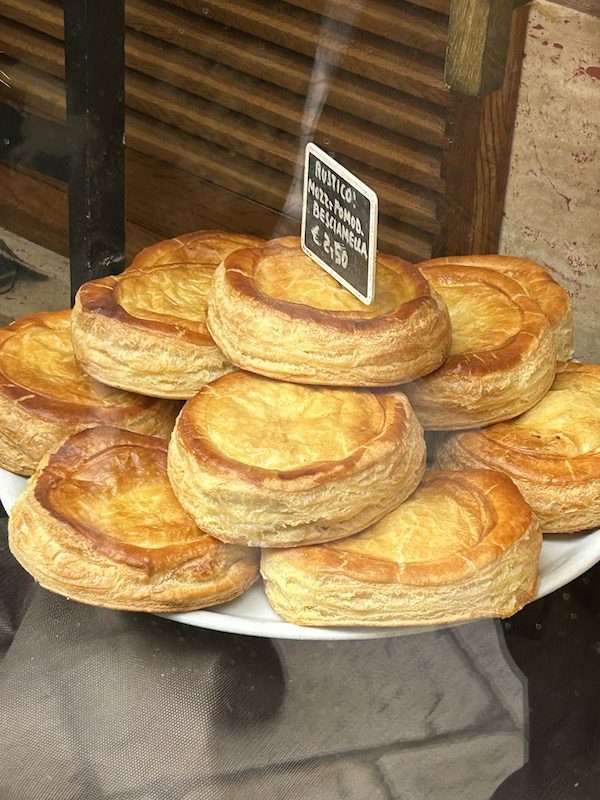
A plate of Rustico Leccese, a traditional puff pastry/ Photo by Carolyn Ray
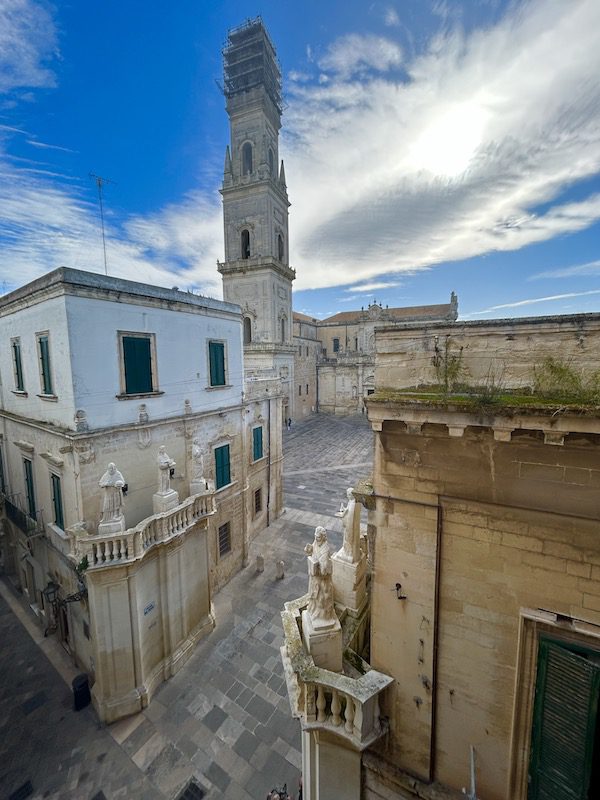
Views of Lecce from my palazzo / Photo by Carolyn Ray
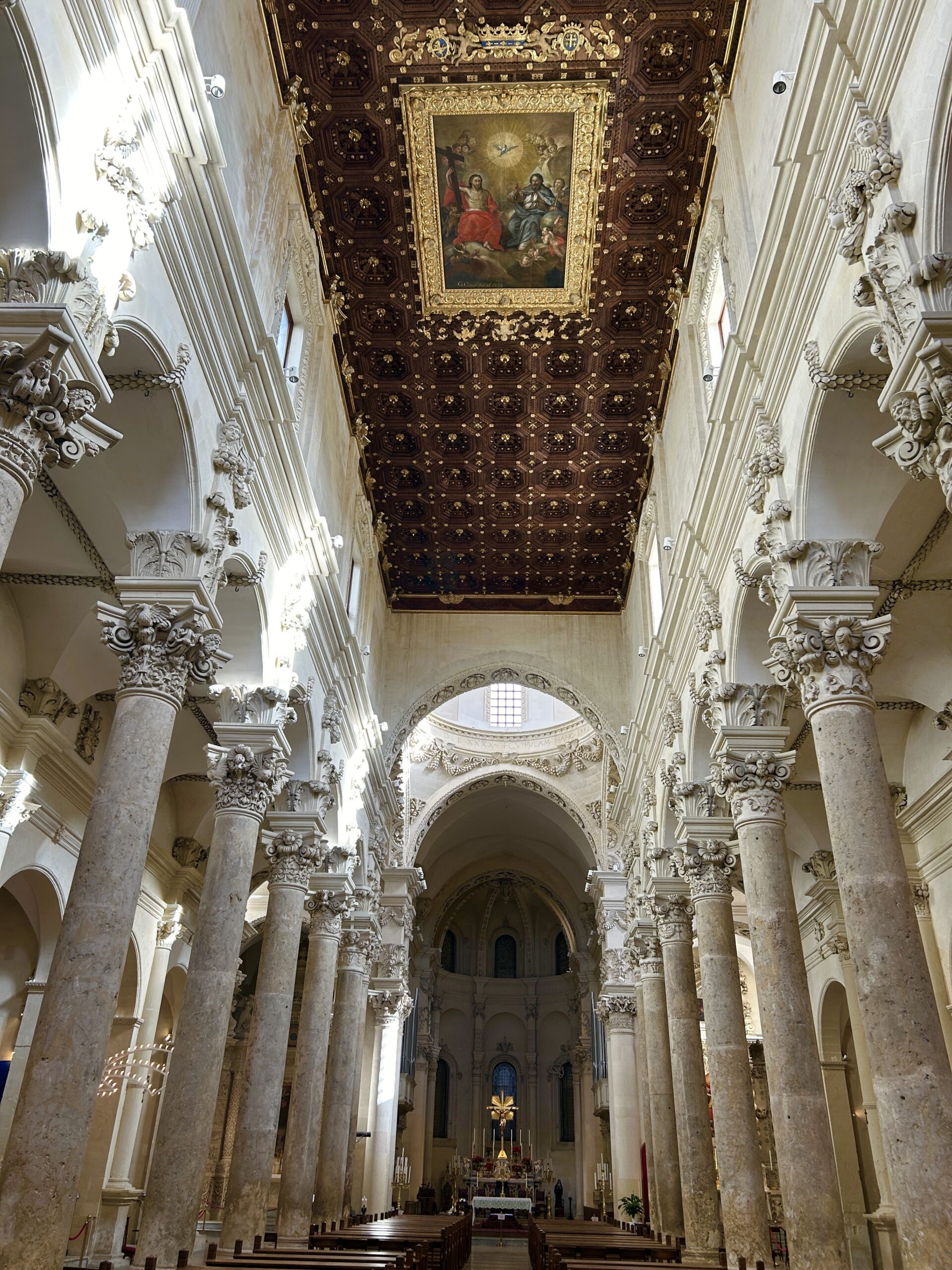
Interior of Basilica di Santa Croce / Photo by Carolyn Ray
5. Embrace the Pastiochioto!
Lecce is a culinary dream, from pastries to pasta and fresh food. There are small markets within the medieval city, as well as a larger vegetable market near Porta Rudiae which is open from early morning to 2 pm. It was here I found stalks of gorgeous artichokes in season, fresh cheeses and vegetables still covered in earth from the ground.
If you can, do a food tour to learn about Lecce coffee, Pastiochioto, the local bread with olives, or rustico leccese, which is puff-pastry filled with béchamel sauce, tomato pulp, fior di latte mozzarella and pepper.
Some of the restaurants I visited and recommend include Blu Notte, La Putea Osteria e Ristoro, Alle du Corti, and Animaterrae Resturant. The only quirky thing I found was that when I offered a seat in a restaurant, that the tables seating four people were often much nice than those for two, which were often near the kitchen. When I asked to change tables, I was told that I couldn’t sit at a table for four, even when the restaurant was empty. Needless to say, I walked out of several restaurants on principle.
6. Stay in a palazzo
A palazzo? Why not! Under the rule of the Kingdom of Naples since 1463, Lecce grew in importance until it became a lively cultural centre that developed trade with merchants from all over the world. As a result, there are palazzos everywhere, and many have been restored or converted into modern luxury apartments, some with ancient Roman ruins exposed by the glass floors.
For my week in Lecce, I found a beautiful family-owned apartment in the old town, once a former palazzo, with a view of the Duomo out my bedroom window and a terrace at the back. Owned by Francesco and his wife, the palazzo has been in their family for generations and it feels like a home. You can book it here. The apartment is two floors up an enormous marble winding staircase with a metal gate at the top and there is no elevator (although I suspect the owner’s sons will help you carry your bags up, as they did for me). There are also some lovely boutique hotels in Lecce, including the Santa Chiara Hotel, which is very close to the main sights. Check booking.com to find one that suits you.
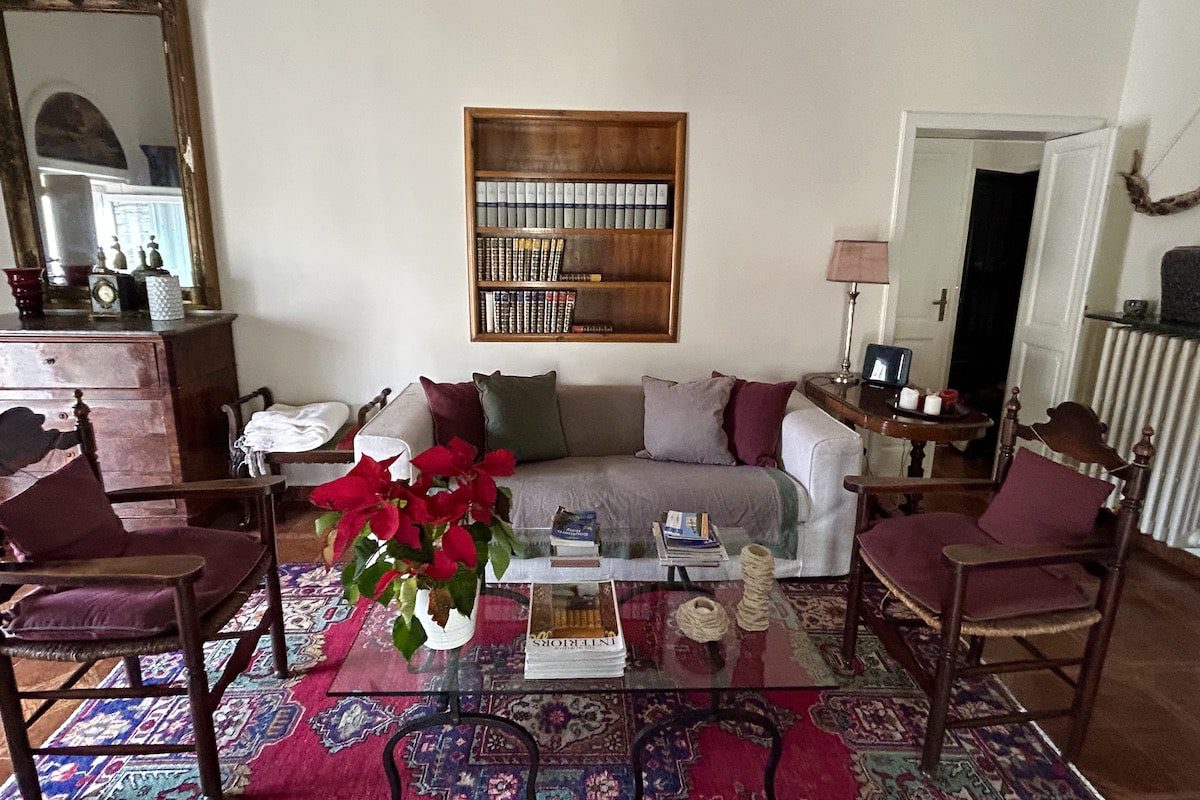
A family-owned palazzo made this trip special / Photo by Carolyn Ray
7. Take a road trip
Lecce is only about a 20-minute drive to the sea, so there are many beaches and bays to explore. It’s very easy to take a road trip day to the toe of Italy, which is less than two hours away. There are many charming seaside towns, including Maglie, Otranto, Leuca and Gallipoli.
If you time it right, you can have breakfast in Lecce, lunch in Leuca and sunset in Gallipoli. There is car rental right in the old town at Palazzo Rollo B&B or you can walk outside the walls to find Budget or Hertz. Find a rental car here.
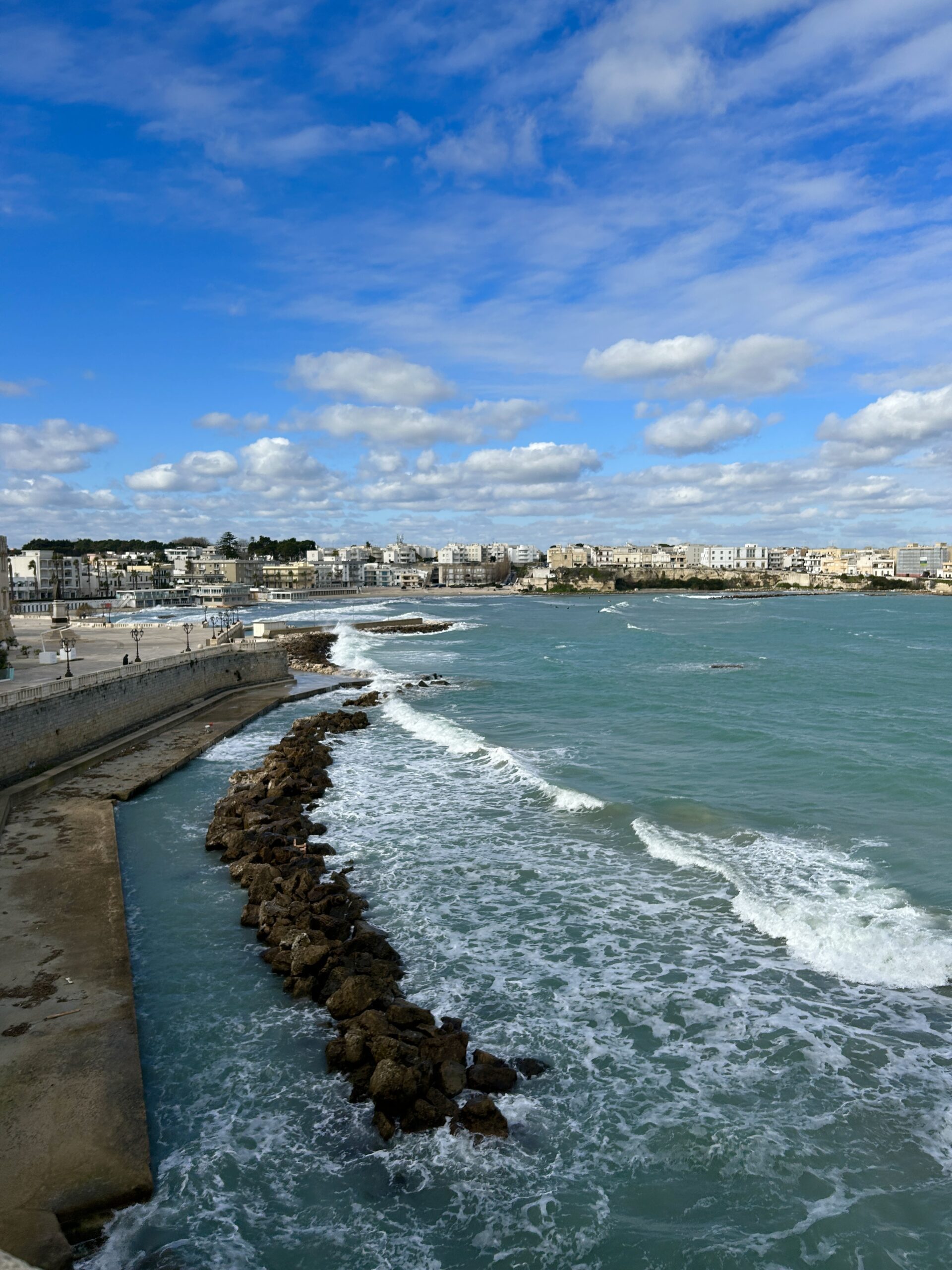
Breakfast in Otranto, the most easterly part of Italy/ Photo by Carolyn Ray
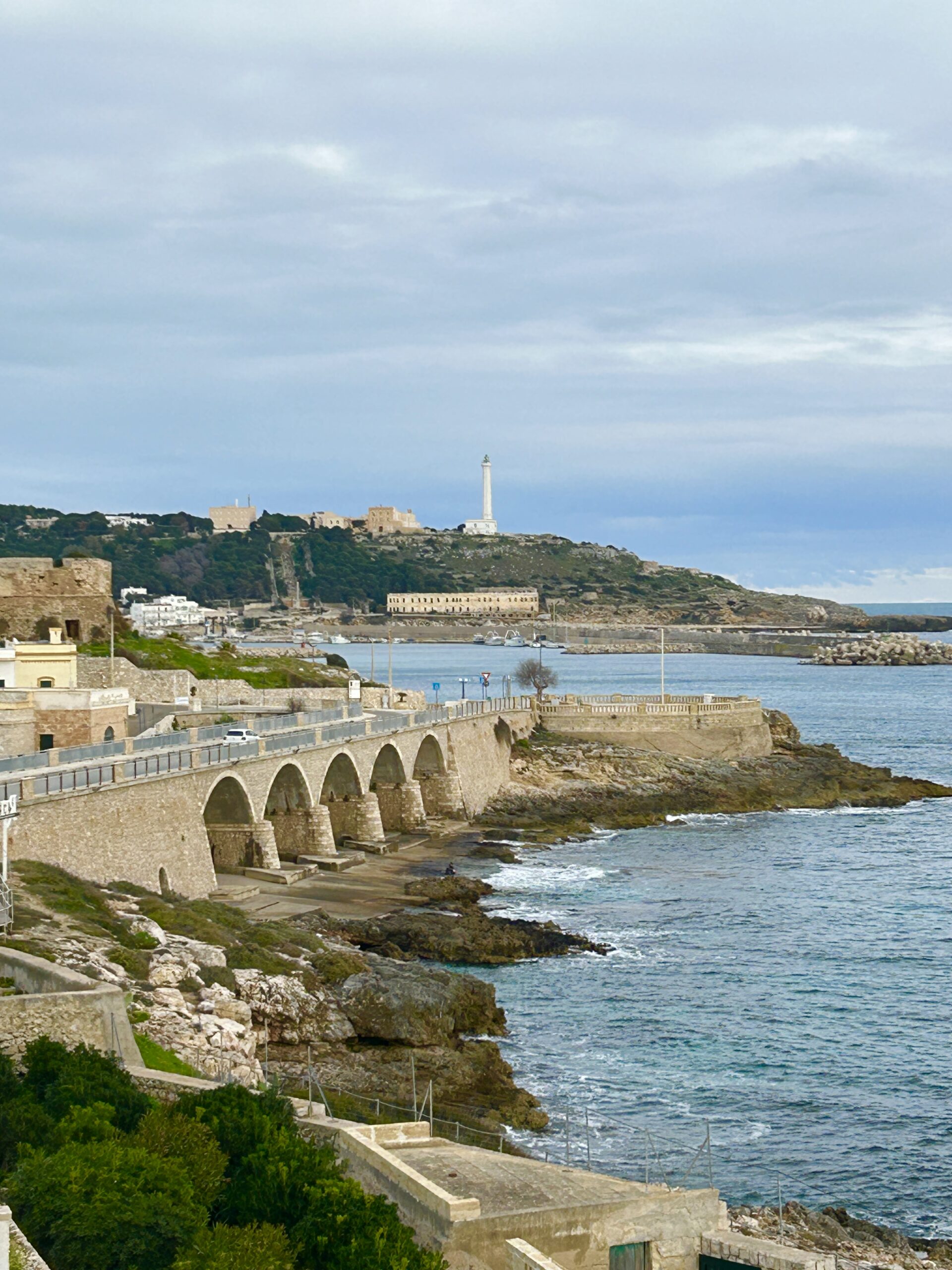
Lunch in Leuca with its famous lighthouse/ photo by Carolyn Ray
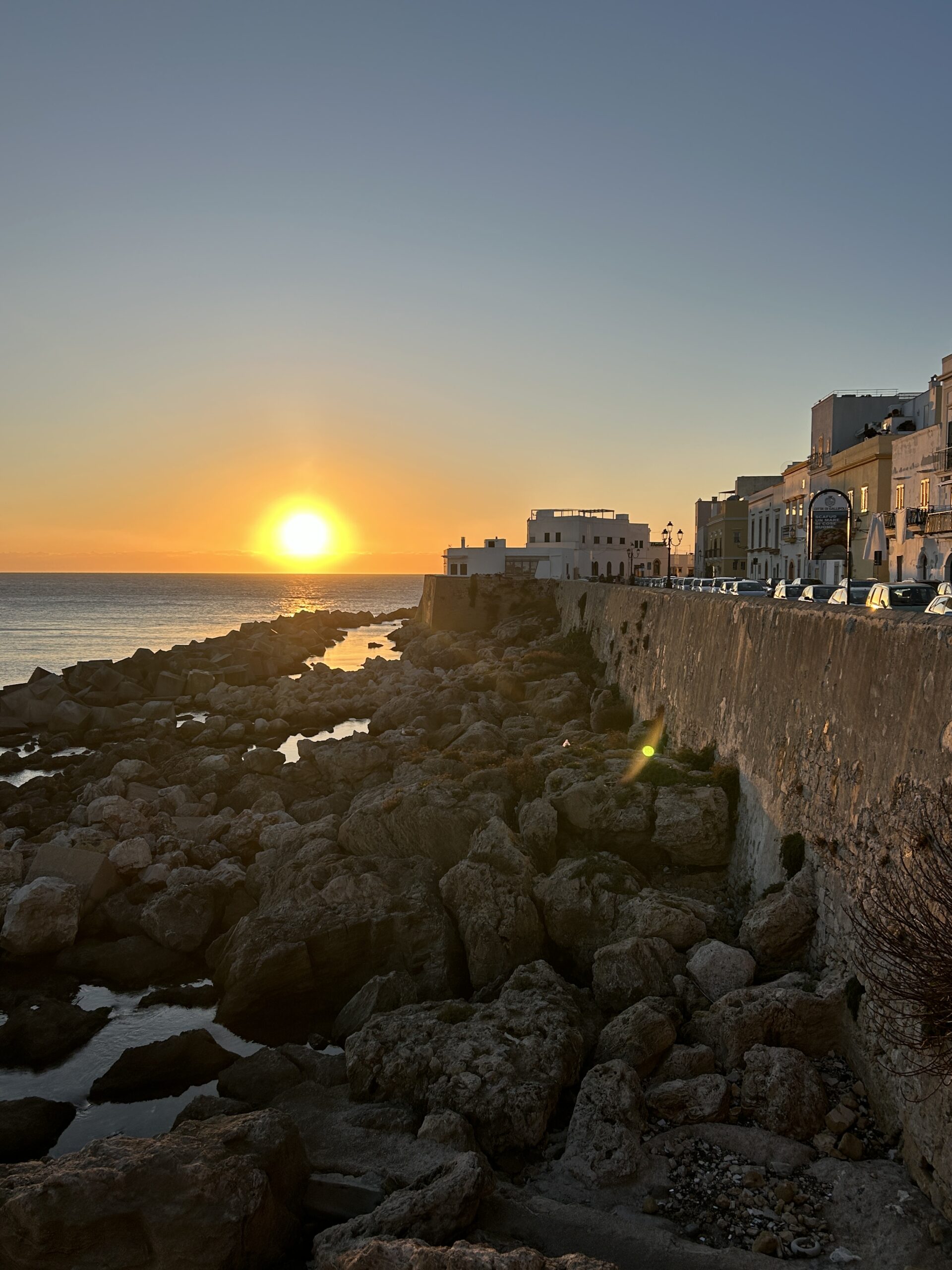
Sunset in the walled city of Gallopolli / photo by Carolyn Ray
A return to Lecce?
Lecce is one of those places I didn’t have enough time to explore. On the morning I left for Sicily, I wandered the streets to say a final goodbye. What didn’t I see? Who didn’t I meet? What didn’t I learn about? What is still left to be discovered? Will I come back or will this be the last time I see these streets, buildings, people and all the things I’ve witnessed?
Of course, when I take that last walk, I always see the places that I didn’t make it to. The restaurants I didn’t try or the shops or historical monuments I didn’t visit. So while there is a twinge of regret, what I’m really doing is putting an imprint in my memory, so that when I come back it will be familiar to me and I will love it even more.
More Stories From Italy to Inspire You
Seduced by Sicily: How Palermo Captured my Heart
With Middle Eastern, North African, Spanish, Greek and Italian influences, Palermo, Sicily, is one of those places that captures your heart.
Ostuni, Italy: Wanders in Puglia’s Magical ‘White City’ in the Off Season
Off-season adventures in the magical ‘white city’ of Ostuni, in Puglia, Italy, which overlooks the Adriatic Sea and olive farms.
JourneyWoman Webinar: Travel to France and Italy With Best-Selling Authors on March 26
Learn how you can travel to France and Italy with best-selling authors on this special webinar presented by Absolutely Southern France.

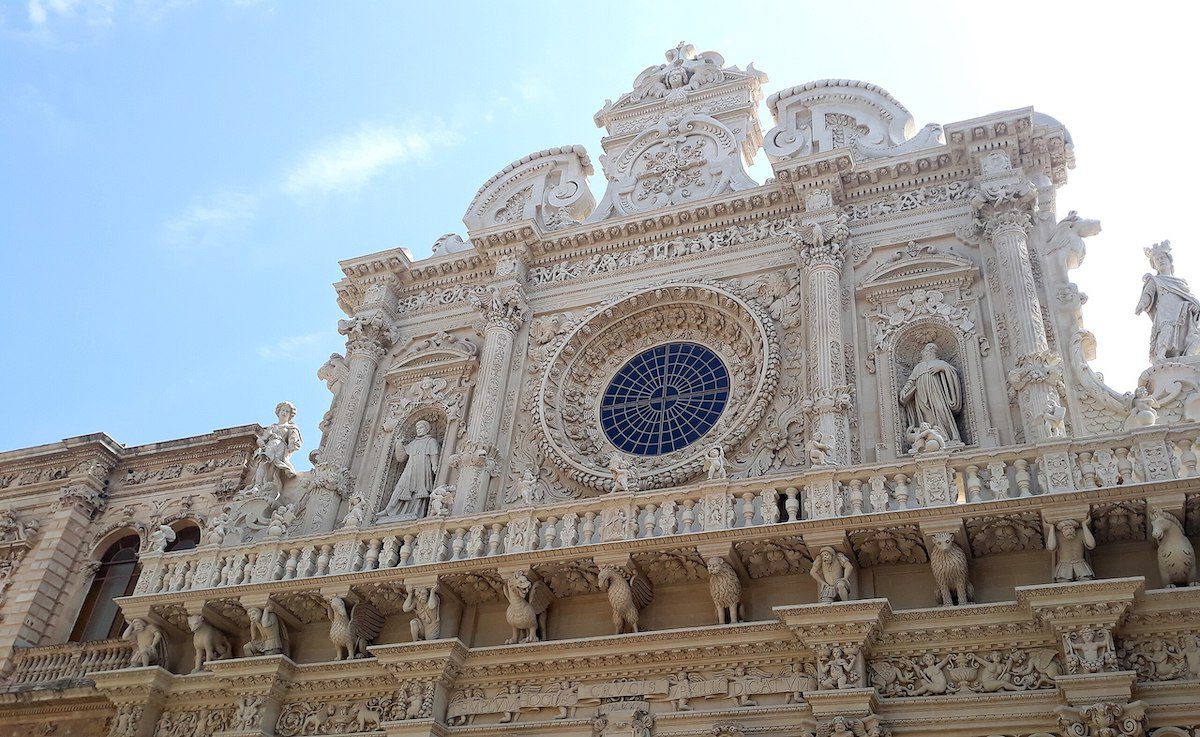



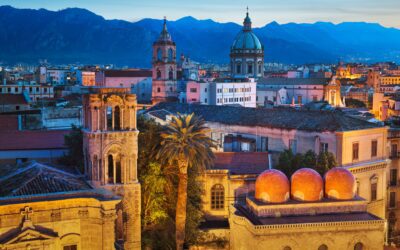
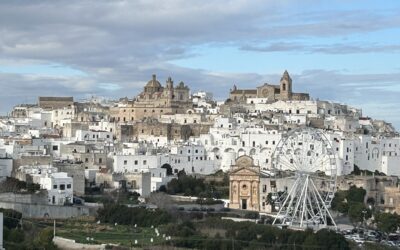
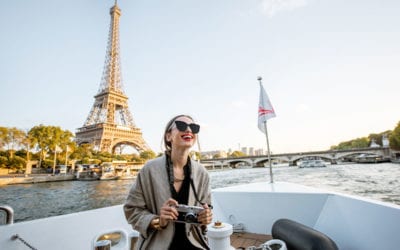
0 Comments
We always strive to use real photos from our own adventures, provided by the guest writer or from our personal travels. However, in some cases, due to photo quality, we must use stock photography. If you have any questions about the photography please let us know.
Disclaimer: We are so happy that you are checking out this page right now! We only recommend things that are suggested by our community, or through our own experience, that we believe will be helpful and practical for you. Some of our pages contain links, which means we’re part of an affiliate program for the product being mentioned. Should you decide to purchase a product using a link from on our site, JourneyWoman may earn a small commission from the retailer, which helps us maintain our beautiful website. JourneyWoman is an Amazon Associate and earns from qualifying purchases. Thank you!
We want to hear what you think about this article, and we welcome any updates or changes to improve it. You can comment below, or send an email to us at [email protected].